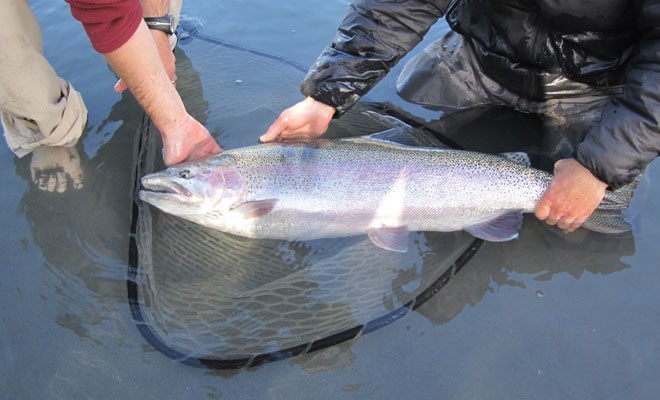
This 35.5-inch rainbow trout was caught after spotting a new school of salmon on the fish finder. © Alaska Drift Away Fishing
Story & Photos by Jeremy Anderson
The sun is about to come up and we just stopped at Cook’s Corner gas station in Sterling, Alaska, for one of their famous breakfast sandwiches. We can’t quite tell how the weather is going to shape out. The weather man said, “Partly just about everything,” which is common for Alaska. Before we back the boat in, we go through our morning routine to make sure everything is ready. Once the boat is in the water, we let the engine warm up and we prep our gear. Throughout this pre-fishing process I think about all the little things that lead to success on the water. It’s the sum of all the little things while prepping and while fishing that make a huge difference while on the hunt for Walter (what we like to call the big one).
Your Boat & Gear Is Where It Starts
I have been in a boat full of clutter with river silt caked on the floor. Did the boat still float? Yes. Did we still catch fish? Of course. I have also spent 45 minutes tied up to shore to retie gear. You’ve probably been there too. But the bottom line is that the more your line is in the water, the more catching opportunity you will have. If your boat is clean and organized and your gear is ready to go, your day is going to be a lot less stressful and you will be able to focus on finding Walter.
Having a clean and organized boat is a great start. I give my boat a quick rinse at the end of the day to make sure the deck is clean and ready to go for the next day. I will also clean my gear to make sure it stays in good working order. When I am going out on a trip, my rule of thumb is to only bring the gear I need that day and I keep it contained in one area, like a rod locker. I pull out a Pips box and a few small bead boxes with some weights and fishing line in case I need to re-tie, and I always keep a pair of pliers with a scissors on my belt. Everything else stays in my trout bag and typically doesn’t get pulled out unless something unexpected happens. When my gear is organized, it is ready to deploy at any moment and I don’t waste time fumbling around looking for things. I also like to keep everyone’s bags, food, and extra clothes stored under the seats so there is room to move around without tripping.
Another critical point to consider is having good gear set up before you leave the house. For me, this is a must. No one wants to miss the best bite of the day because they are tying gear. Being prepared will give you that one extra drift that could result in the big trout of the day. I always check and pre-tie all my rods prior to my trips. I also carry a Pips box with 35 pre-tied leaders, so it is an easy swap if I need a new hook or the line is frayed. I might go through a few more leaders than the average person, but I am not willing to gamble on a 15-pound rainbow trout with a hook that isn’t sharp or a leader that has an abrasion. It is also important to have a good stock of beads and flies that you know are going to catch fish. I make it a priority to have a bead or fly that is one variation off what was the best choice yesterday. You have to stay on your trout game to have consistent good days.
Another piece of gear that you should put in your boat is a sounder. It will help you understand important factors about what is going on underneath you, like water depth, water temperature, bottom structure, and where the fish are. In 2010, I was fishing with a military group from Anchorage. We were approaching an area that I had been catching more fish in lately, and as I went through a tighter channel my sounder started blowing up with fish. I decided to stop and start there instead. In our first drift we tied into several trout, one about 25 inches, and another a whopping 35.5 inches. Yes, that day we found Walter, a 22-pound rainbow trout. However, if I had not heeded the new information on my sounder, we wouldn’t have fished that spot at that exact moment and those two big rainbows wouldn’t have reached our net.
The River & the Fish Care About the Little Things, Too
When thinking about the river and the rainbow trout it is important to realize that constant change is the name of the game. There are some facets that remain constant, but having the knowledge to make a good in-the-moment decision is crucial to better results. I like to look at it like a mystery or puzzle where each experience I have helps me for the next. Topics such as boat control, the sweet spot, water levels, spawn, food lanes, and timing have a lot to do with upping your trout game on a daily basis.
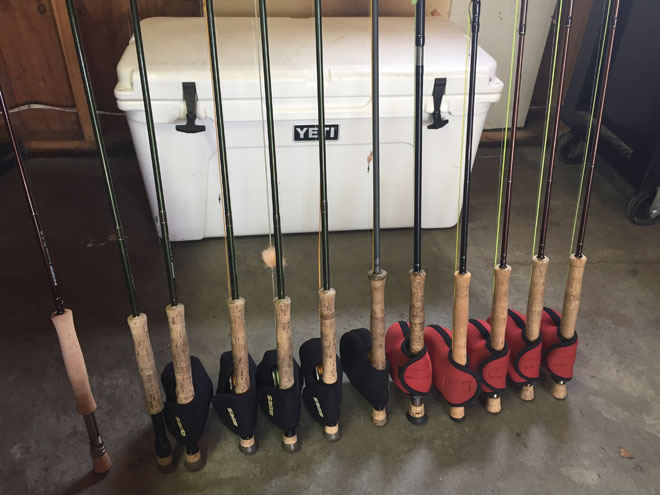
Organize your gear before fishing. © Alaska Drift Away Fishing
Accurate boat control is vital. As the skipper, you must be intentional behind the motor or oars. You need the ability to put the boat exactly where you want it. You need the ability to control your speed in the current. If you can develop a strong grasp of both then your drift will be more accurate, and that will result in more fish. Often times, people move the boat more than they need to. I will often close my eyes and simply feel how the boat is floating in the current. If I feel resistance then I know it’s time to go with the flow of the river a little more. Most importantly, learn the river and plan ahead to get your boat where you want it. Don’t try to force it if you’ve missed it—either motor up and position yourself early or row down to the next hole.
The sweet spot is a riffle, slot, hole, seam, drop, or whatever you want to call it where you know you are going to catch something. I like to consider this my baseline of the day. Each day I go to my sweet spot to get reacquainted with the river and fish, and it helps me understand what has changed since yesterday. Here are a few questions I ask myself in the sweet spot: Did the drift fish the same? Are the fish in the same spot or did they move slightly? Do the trout want the same bead or a different color or size? Hitting the sweet spot early in the day helps me make good choices the rest of the day.
Water levels are constantly changing, but are an important consideration each day. Train your eyes by choosing a few markers, like the shoreline or a rock in the water, and gauge their level of exposure to tell if the water levels have gone up or down each day. I also use an application on my smart phone called Fishhead, which allows me to see how the water is changing in real time because it is connected to flow stations on the river. It is an amazing tool to use that picks up on the subtleties you can’t necessarily see with your own eyes. When water levels change, so do the locations of the fish. Being aware of this will up your trout game.
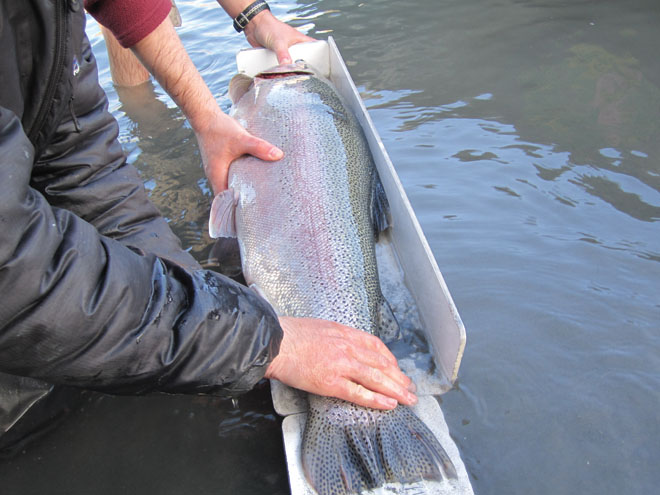
This slab of a rainbow, aka Walter, is what drives many of us to fish long hours in Alaska. © Alaska Drift Away Fishing
The spawn and food lanes for trout are directly affected by water levels. Each year we see schools of salmon move quite a bit when the water changes volume quickly. It’s an easy adjustment if the water drops but if the water volume is rising then the salmon have more room to move around and find their new happy place. Find the salmon and you will find the food lanes downstream. If you are catching more salmon than trout, you are probably right on top of the spawning grounds. Your best bet is to move below the salmon where the water flows into the food lane. Food lanes change daily, and sometimes hourly, so you have to really pay attention to water levels and spawning salmon. The rest for this one is up to you to figure out on the water.
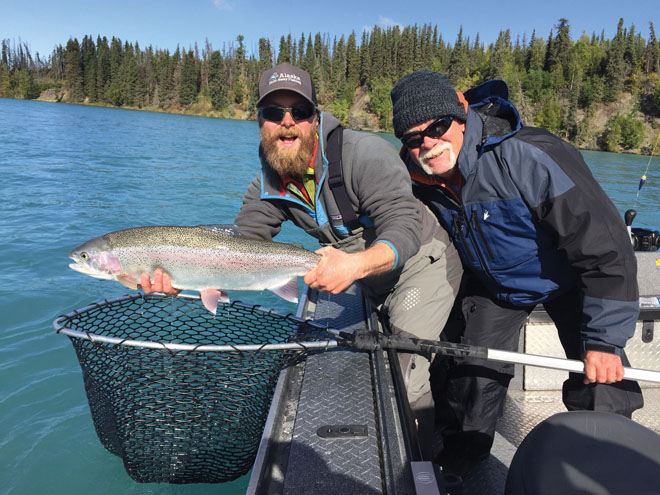
A 27.5-inch Kenai River rainbow trout caught during the best bite of the day, which was only about a 30-minute window that day. © Alaska Drift Away Fishing
Timing is one of the biggest make-or-break factors in the trout game. There are a lot of quality rainbow trout in the Kenai River, but if the conditions aren’t right, then you won’t see them. Each bite of the day has its own value and payoff, but every day I take note of the first bite, the last bite, and the best bite session. These can change daily, and after the river goes through a major event, like a flood or a muddying, it takes time for the river to stabilize and fish to be active again. Staying knowledgeable through these changes requires a lot of time on the river and/or good communication with fishing buddies. This knowledge allows you to know your timing and to get away from other anglers and pressured waters.
Little Big Things for Your Fishing
The little things in your setup are especially important when you are on the river. Simply upsizing your bead, changing your fly, removing weights, or increasing your leader length can change your day to a “fish on” experience. My rule is simple—make one change at a time to isolate the cause-and-effect relationship of your changes. In high water add some length to your leader. In water with less visibility upsize your bead or fly. In slower water reduce weight a little. If the fish wanted old beads yesterday and that bead isn’t working today, the quick fix is to put on a fresh bead. If that isn’t working, go back to an old bead that is one shade different than one you started with. With flesh flies, it is important to not change the major tone of the color but think about changing the highlights of the fly a little bit. With leeches, I only have a few patterns in my quiver but in multiple colors and sizes. If one option isn’t working another option will.
In terms of presentation, sometimes rainbow trout want a straight up dead drift. Other times the trout get really excited when you swing your fly right in front of them. And at other times, a dead drift with a slight swing at the end of the drift is the best drift for the day. Also, the river will dictate whether you have a better drift casting towards shore or from shore towards the main channel. Find out which works better in each spot through what we like to call research and development. In other words, get out there and fish it.
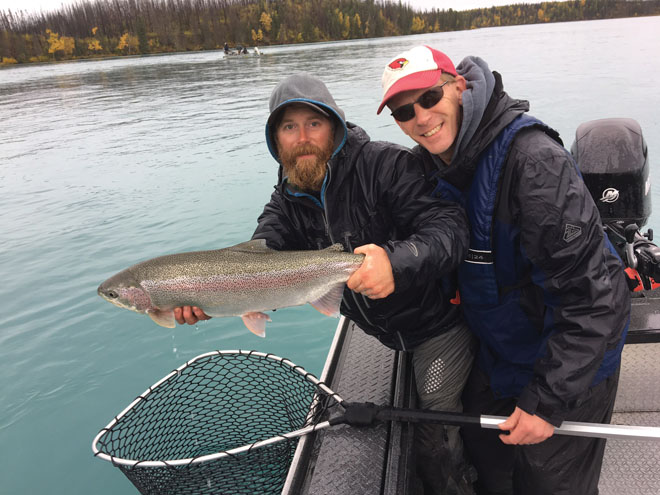
This trout was caught in on the many “sweet spots” during the 2017 fall fishing season on the middle Kenai. © Alaska Drift Away Fishing
It’s important to continually self-reflect on your choices as a fisherman and to create a place for past experiences to live so you can start to see trends and grow your depth of knowledge on rainbow trout fishing. Some people have a photographic memory and others need to write things down. When I first started fishing the Kenai, it was suggested that I use a daily journal and write down everything, including weather, water clarity, what beads/flies worked, where the trout were, and any other detail to help paint the picture of the day. I was diligent for a few years and it was amazing how well it worked. Over time I used the journal less and now not much at all, but I think that the value in tracking the river and the fish is unmatchable until it becomes second nature to you. Now I keep a photo journal of the flies and beads I produce and a sample of each one that worked well. The bottom line is to develop a tracking system that works best for you.
Tying it Together
Give a long, hard look at how you operate your program, and you will have a better vision to reflect on. Everything you do throughout your day, whether on purpose or by accident, is an integral factor in the outcome of your fishing trips. Remember that there are important things you can do even before you get on the water with your gear and boat. The more you are ready before you put the boat in the water, the more time you will spend with your line in the water. Recognize what the river and fish are providing you today, so you can incorporate that data into your future fishing plans. Don’t be afraid to change your plans up if other indicators tell you to. Take ownership of your fishing decisions and don’t be afraid to try different things to see if it helps. Remember that fishing is all about fun on the water with the people you are with, but why not come prepared with your little things and let them add up to finding Walter?
Jeremy Anderson is one of the three co-owners/guides who operate Alaska Drift Away Fishing.
This article originally appeared in the April 2018 issue of Fish Alaska.
